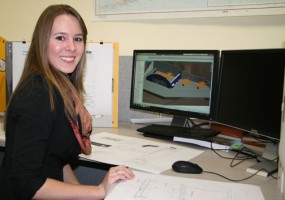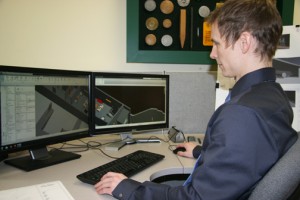Beyond the lecture—solving problems in the real world
by Jess |
For nine students in the architectural and engineering technology program, theory turned to reality when they were tasked with developing building-design concepts for a local organization.
The students are part of AET 121: Architectural Drafting offered by the UAA Community & Technical College's Construction & Design Technology Division. The course's applied curriculum is the brainchild of Associate Professor Brian Bennett. For more than 10 years, he has leveraged hands-on learning projects to instruct UAA students.
Along the way, Bennett has partnered with local organizations to bring design projects into the classroom. This has benefited students by providing them with the opportunity to conceptualize designs, to learn Revit, a building information modeling software, and to work within a professional client-based relationship.
"We tell clients during the introduction to the process that the goal is to help them come to a better idea of what they want in a shortened time frame," said Bennett. "We provide many different solutions so that clients can narrow, combine, refine, and reject the choices or parts of them. Past clients have commented that they have a better understanding of what they want and don't want out of their project when they do approach an architect or engineer."
The projects that have surfaced are varied, from turning a recreational vehicle sales and maintenance building into a community outreach center to designing stations to facilitate a walking tour of a new community park. Bennett noted that he doesn't solicit projects from organizations but that word of mouth from past participants has been a powerful endorsement, creating a steady flow of opportunities.

Megan Endreson shares her designs during an open forum
attended by project stakeholders, industry partners,
advisory board members, and campus community members.
Photo courtesy UAA Community & Technical College.
During the spring 2014 semester, students worked on a project for Chignik Lagoon Native Corporation. The group plans to build an energy-efficient, environmentally friendly, multi-use building, but the core of the building will be an airplane hangar. The new facility will be located on the Alaska Peninsula. It is the first of a multi-phase building project, and students were asked to design the facility with expansion in mind to accommodate a small café, medical clinic, and rental space.
Students approached the project with a mix of enthusiasm and trepidation, anxious about mastering Revit while they each drafted a design.
"Revit's hard to learn," said Megan Endreson. "You spend the first week of class banging your head against the screen. You just have to experiment with it yourself."
In spite of the challenge of learning Revit, Endreson's enthusiasm about the project was palpable when she and other students showcased their designs during an open forum that marked the end of the intensive five-week course. Invited guests included all stakeholders for the project, local architects, contractors, community members, academic advisory board members, and UAA faculty members and administrators.

Megan Endreson's rendering of the exterior of the airplane hangar. Image courtesy UAA Community & Technical College.
Endreson shared that she had spent hours doing research. She looked at satellite images on Google maps to better understand the topography of the area so that the building design would fit in with the natural environment. She also spent time identifying the best doors to use for an airplane hangar, determining that the doors should slide into the building to prevent snow from building up along the tracks. She even interviewed her roommates, who happen to be pilots, to get a firsthand perspective of what they value in a hangar design.
The course paid off for Endreson in big ways. Her academic interests are broad, and she had been trying to identify a degree that would be a good fit.
"I like communication. I like psychology-people and spaces," said Endreson. "I like math, and that's all the structural sort of stuff. Science-you're dealing with the earth and materials, and I like all those things. So, I've never been able to choose a degree. So, I finally feel like I found something that incorporates a little bit of everything. I enjoy all aspects of designing a project and now believe this is the right field for me."

Kris Brons hopes to use his design skills to enhance client communication in the
architecture industry.
Photo courtesy UAA Community & Technical College.
While Endreson's experience has been one of discovery, classmate Kris Brons' has been one of retooling. Brons is from a construction background and has more than 15 years of industry experience. He decided to move out of construction when he realized that the physical demands of the work were taking a toll on his body. He has a clear vision for where he plans to take his career next.
"I'd like to work in 3-D arts, moving more into the presentation side," said Brons. "I'm thinking about taking some additional graphic arts classes and finding a niche in the architecture industry with client communication. I think that it's important because, working in the field, you see a lot of errors and expense that could potentially be overcome with better communication. With the technology advancing the way it is, we can eliminate a lot of those headaches for the contractors and expense for the client by solving problems ahead of time."
Seasoned civil engineer Mike Redmond attended the forum and asked students questions about their projects. Redmond sits on the Construction & Design Technology Division's Construction Management Advisory Board. He shared some tips from his 35-plus years in the field. He encouraged students not only to pursue courses within their program but also to consider taking classes such as persuasive speech and writing to enhance their communication skills. He stressed to students the importance of clearly articulating the benefits of their design to clients.

Kris Brons' rendering of the exterior of the airplane hangar.
Image courtesy UAA Community & Technical College.
"As an architect you want them to be delighted and excited about the building because it meets their needs," he said.
When asked if they would change anything about their designs in hindsight, both Brons and Endreson indicated there are changes they would make. Brons shared that he would add skylights to allow more natural light into the building, especially with Alaska's long dark winters. Endreson wistfully replied that she wished she could take her design a few steps further.
"The benefit of the course is that the problem does not come in a book," said Bennett. "Students benefit from critical thinking, decision making, and investigation about things the instructor does not have direct answers to."
It's easy to see why Bennett continues to wield applied learning-it extends the students beyond their tools, leaving them with a hunger to keep improving upon their work in order to create a customized design for a satisfied client.
Note: The Chignik Lagoon Native Corporation evaluated students' designs following completion of the course and awarded a $750 scholarship to Megan Endreson for excellence in executing the design specifications. Congratulations, Megan!
This story by Kirstin Olmstead, CTC Communications Coordinator, first appeared in the Community & Technical College's Insider blog on April 4, 2014.
 "Beyond the lecture—solving problems in the real world" is licensed under a Creative Commons Attribution-NonCommercial 4.0 International License.
"Beyond the lecture—solving problems in the real world" is licensed under a Creative Commons Attribution-NonCommercial 4.0 International License.














